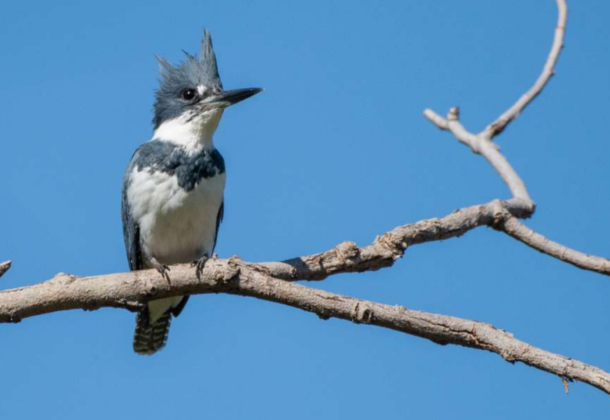Message from the Cap’n – Maryland’s Belted Kingfisher

Message from the Cap’n is a compilation of fishing advice, waterman and weather insights, Chesapeake lore, and ordinary malarkey from the folks who keep their feet wet in the Potomac and St. Mary’s rivers.
Growing up, we always loved to see this wonderful bird flying around the small pond behind our little farm in Piney Point.
The Belted Kingfisher is a stocky bird with a large head. It grows to be between 11 and 14 inches in length with a wingspan of 19 to 33 inches. It has a shaggy crest on the top and back of its head; a short, thick bill; and short legs. Its medium tail is square-tipped.
The Belted Kingfisher is powder blue on top with fine, white spotting on its wings and tail. Its white underparts also feature a blue breast band. Females have a broad, rusty band on their bellies while juveniles have irregular rusty spotting on their breast band.
Among the nearly 100 species of kingfishers, the sexes often look alike. However, the Belted Kingfisher is one of the few bird species in which sometimes the female is more brightly colored than the male. In some species the male is more colorful, and in others the female is.
In what makes the Chesapeake such an inviting home, the kingfishers patrol rivers and shorelines, and burrows along earthen banks. They feed almost entirely on aquatic prey, diving to catch fish with its heavy, straight bill. Breeding is limited by suitable nesting sites, however human activity, such as road building and digging gravel pits, has created banks where kingfishers can nest and allowed the expansion of the breeding range.
During breeding season the Belted Kingfisher pair defends their territory against other kingfishers. A territory along a stream includes just the streambed and the vegetation along it, and averages 0.6 mile long. The nest burrow is usually in a dirt bank near water. The tunnel slopes upward from the entrance, perhaps to keep water from entering the nest. Tunnel length ranges from 1 to 8 feet.
Although Belted Kingfishers are common along streams and shorelines across North America, they but can be elusive. You’ll probably hear a loud, rattling call before you see the kingfisher. As they patrol their territory they typically use the open space above the water as a flyway and they often perch on riverside branches and telephone wires.
Belted Kingfishers wander widely, sometimes showing up in the Galapagos Islands, Hawaii, the British Isles, the Azores, Iceland, Greenland, and the Netherlands. And it seems they’ve always been wanderers. Pleistocene fossils of Belted Kingfishers (to 600,000 years old) have been unearthed in Florida, Virginia, Tennessee, and Texas. The oldest known fossil in the kingfisher genus is 2 million years old, found in Alachua County, FL.
Keep your eyes peeled for these flying jewels. They are year-round residents in the Chesapeake Bay region, pairing up each year for their April through July breeding season.
Till next time, remember “It’s Our Bay, Let’s Pass It On.”
To learn about tours and trips into the Chesapeake, keep in touch with Fins + Claws on Facebook. Catch up on Messages from the Cap’n Member Page. Please visit Cap’n Jack’s lore and share with your social media sites. Or reach him here: [email protected] or 240-434-1385.
























